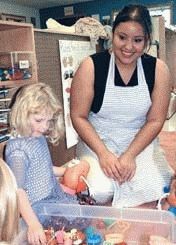COLLEGE STUDENTS AT WORK
Published 12:00 am Thursday, October 9, 2003

- HOLDS TWO JOBS: Eastern student Veronica Nunez, 22, of Vale works four afternoons a week as a teacher's assistant in the local Head Start program. She holds down two jobs and carries a 15-credit hour school load. (The Observer/PHIL BULLOCK).
By Bill Rautenstrauch
Trending
Observer Staff Writer
Every autumn, La Grande’s population swells with an influx of students ready to begin the school year at Eastern Oregon University.
They’re young people, most of them, and they face huge expenses: tuition expenses, book expenses, housing expenses, food and clothing expenses, and more. Much more.
Trending
They cover the costs with help from student loans, government grants, scholarships, wages earned during the summer. Parents chip in when they can.
But the costs keep going up. And there never seems to be enough money.
To get more, students work through the school year, too.
There aren’t any solid figures on the number of students added to the local work force each school year, but there’s one inescapable conclusion: it’s a significant portion of the university’s 3,000-member student body. Hundreds find work with the university’s help, and hundreds more find jobs independently.
The university itself is a major employer of students.
According to statistics from the university’s career service center, about 600 students worked on campus last year, either in the university’s federally subsidized work-study program, or hired independently by the school.
The university helped many other students find work off-campus, said Jana Parmele of the school’s Job Location and Development, or JLD, program.
Parmele said the JLD helped over 300 students find private sector, off-campus jobs last year. Among them, they earned over $900,000.
The JLD is the program tasked with helping students find work in the community. Part of its mission is to develop a strong relationship between the university and prospective employers.
"We get three or four calls a day from employers with jobs available for students. We direct students to where they can find those jobs," Parmele said. Job listings are routinely posted on the Career Service Center’s Web site.
Though the JLD program helps students and employers connect, Parmele is careful to note that the program is not a job placement service or an employment agency.
The university’s work-study program also offers a way for students to earn money, though it by no means provides a living wage. Work study students are limited to working 20 hours per week, and the maximum award is for $1,500 per year.
The application process is a difficult one, said Carol Raphael, Interim Director of Financial Aid.
"It’s worse than filling out an income tax return," Raphael commented.
But a plus and a big plus at that is that students often get to work in their area of study.
Raphael recalled an education major who wanted to tutor local schoolchildren in both reading and math.
"I told him that there probably wasn’t enough work study to cover it all, and he said, ‘That’s OK. When I run out, I’ll volunteer.’ I thought it was neat he was willing to volunteer in order to do something he wanted to do," Raphael said.
Sally Click of the University’s Career Services Office said the federal government provides $200,000 per year for the local work-study program.
"Part of that money funds a position in the career center office. The rest of the pot is shared by the students," Click said.
Every little bit of cash helps, and students involved with the university’s work-study program make little enough. A recent sampling of work study jobs posted on the university’s Web site shows most paying $7-$7.50 an hour.
Jason Yohannon of the La Grande office of the Oregon Employment Department said no accurate figures exist as to the total student work force in and around La Grande.
The department has no special programs for placing students in jobs, he said.
Yohannon said that most students taking jobs during the school year will be found in the service sector.
"Scheduling flexibility is an important factor. A factory job with a rigid schedule probably is not a good fit," he said.
No matter how or where they find their jobs, students working their way through college live at a pace that gives real meaning to the phrase "burning the candle at both ends."
Veronica Nunez, 22, of Vale, works as hard as any student attending EOU. But she doesn’t seem to mind.
A sociology and social welfare major set to graduate at the end of the current school year, she holds down two jobs and carries a 15-credit hour school load.
"I am the third of three sisters in my family going to college. Our parents couldn’t afford to send us all to school. We had no outside help. We had to work," she said.
Nunez goes to classes five mornings a week, and works four afternoons a week as a teacher’s assistant in the local Head Start program.
On weekends she works as a dispatcher at the U.S. Forest Service’s Northeast Oregon Interagency Dispatch Center.
"The two jobs come out to full time," said Nunez, who also worked three recent summers as a Forest Service firefighter.
She added, "Both my employers are really good about my schedule. If I have a study session, they let me go to it."
The seven-day-a-week grind is a tough one, but Nunez said she has no trouble keeping up with its demands.
"Working helps me keep my focus. It helps me stay on track. I would encourage other students to work. It makes college worth it," she said.
Her health insurance and her car payment take big chunks out of her paychecks each month, but she doesn’t consider herself poor.
"I have roommates who help with the rent, and that’s a big plus. I’m not uncomfortable, financially," she said.
Janelle Harrington, a junior enrolled in the university’s nursing program, is working two jobs also. But increasingly, she feels she needs more time for her studies.
Harrington, who hopes to be a pediatrician someday, is a teller in the La Grande branch of the Bank of America.
This past summer she worked also as a secretary in the university president’s office. She has decided to give up that job.
"Working and going to school is a difficult challenge," she said. "I like to give 110 percent to my schoolwork and that was getting hard to do with two jobs," she said.
Harrington said she finances her education through student loans and her wages.
"My parents are great and they help when they can, but it’s limited," she said.
She said she is looking forward to the break from a two-job grind.
"You’ve to to have time to play," she said.
Employers thinking of hiring student help this year should call Parmele, 962-3588.









